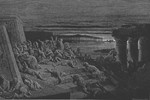
Stress & Mutability
"Man's yesterday may ne'er be like his morrow;
Nought may endure but Mutability" (ll.15-16).
P. B. Shelley's "Mutability" (1814-15; 1816)
Points
for Reflection
Dystopic Revelations
- Are the large-scale catastrophes faced by human societies throughout history more often a function of our own actions, or of forces outside our control?
- How often do dystopia and utopia intersect, or even cohabitate?
- In your experience, what types of stressors prove the most difficult to deal with, and to which do you adapt relatively rapidly?
- How does intense stress affect your perception of reality?
- In what physical environment do you feel the most comfortable? The least comfortable?
- What type of alteration to your body do you fear the most, and why?
- How does humanity redeploy buildings in the midst of a crisis?
- How might humanity redeploy buildings during a lasting dystopia?
- What types of relational dynamics prove most resilient amidst large-scale catastrophes? Marital? Parental? Sibling? Neighborly? Civil?
- Upon which of the following institutions do modern peace and prosperity rely the most? Law enforcement, the justice system, the education system, religious organizations.
P. Shelley's "Mutability" (1814-15; 1816)
- What do the visual and aural similes used by the poet across the first two stanzas share in common? They work together to suggest what about the human condition?
- Does the poetic form of these initial stanzas reflect/reemphasize their thematic content?
- Does the narrator claim that mutability affects the individual human's mind as well as her/his heart?
- What is the tone of this poem? Is Percy Bysshe Shelley's narrator joyful, depressed, or something else?
W. Wordsworth's "Lines Composed A Few Miles above Tintern Abbey" (July 1798; 1798)
- In the first stanza (ll. 1-22), what subject matter does Wordsworth make romantic that would normally seem undesirable? [from this point on, I will assume the narrator of "Tintern Abbey" and the author himself constitute a single voice]
- In what way does Wordsworth anticipate Freud in ll.30-35?
- Be ready to summarize the passage (ll.22-49) in which Wordsworth details the type of feelings and mood which Nature gave him in the rural past and which he has learned to carry into his recent, urban experience.
- In what way does Wordsworth's youthful experience of Nature differ from the manner with which he now responds to it?
- Does the narrator's high appreciation of Nature in lines 93-111 approach a form of idolatrous worship, or does Wordsworth consider Nature primarily as a conduit to something greater/deeper than Nature itself?
- As construed by Wordsworth in the poem's final section, does the most profound type of communion with Nature require solitude, or the presence of others?
Lord George Gordon Byron's "Darkness" (1816; 1816)
- What drastic measures does humanity take to create illumination when utter darkness descends on the world?
- Does humanity band together in the face of this cataclysm?
- Does the behavior of animals mirror that of humans?
- Does their appear to be a way out of this crisis?
R. Browning's "Love Among the Ruins" (1853; 1855)
- What topical focus does this poem share with Percy Bysshe Shelley's "Ozymandias"?
- Does the physical description of this ancient city sound fantastic or realistic?
- Is the culture remembered by the narrator replete with honorable virtues?
- What single vestige of this ancient culture's civilization still exists in visible form?
- Which assumes a louder and more emphatic voice, this poem's implicit indictment or its explicit celebration?
- Is the poem's message as simple as its final line?
- In Victorian Poetry: Poetry, Poetics and Politics (1993), the literary critic Isobel Armstrong suggests that the short, three-syllable anapaests interspersed throughout Browning's poem "Love Among the Ruins" could be removed without changing the essential meaning of the longer, 11-syllable lines that precede them (Armstrong 18). Is this uniformly true, or can you locate exceptions? (Armstrong herself identifies two exceptions: see if you can locate these, and perhaps some others.)
- How do these shorter anapaestic lines alter the poem's tone and theme?
- Armstrong also suggests that this poem "enacts and subverts a contemporary mythos inherited from Romantic values, a myth about the all-sufficing energies of mutual passion and the setting up of private enclaves of feeling against the crude values of threatening culture" (Armstrong 20, my emphasis). Do you agree?

The Chancel and Crossing of Tintern Abbey, Looking towards the East Window (1794)
J. M. W. Turner
Dr. Paul Marchbanks
pmarchba@calpoly.edu
![]()
